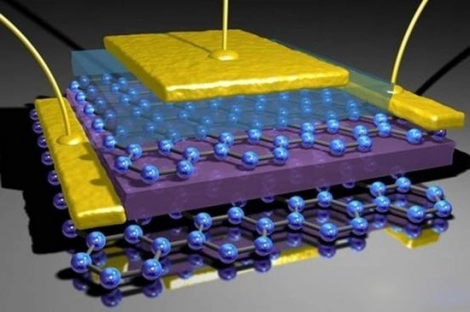Graphene battery
Guoan Energy Technology (Dongguan) Co., Ltd. R&D Center Editor
Graphene batteries are batteries developed by Nanotek Instruments in Ohio, USA, utilizing the characteristic of lithium ions shuttling rapidly and massively between the graphene surface and the electrodes. Development Prospects: The success of the experimental phase of the new graphene battery will undoubtedly become a new development point for the battery industry. Battery technology is the biggest hurdle for the vigorous promotion and development of electric vehicles, and the battery industry is at a stage where both lead-acid batteries and traditional lithium batteries have encountered bottlenecks. After the successful development of graphene energy storage devices, if mass production can be achieved, it will bring new changes to the battery industry and even the electric vehicle industry.

Due to its unique properties, graphene is called a "magic material," and scientists even predict that it will "revolutionize the 21st century." Professor Colin Bailey, Vice-President of the University of Manchester, said: "Graphene has the potential to revolutionize a vast number of applications, from smartphones and ultra-high-speed broadband to drug delivery and computer chips." Recently, researchers at the University of California, Los Angeles, have developed a graphene-based miniature supercapacitor that is not only small in size but also charges 1000 times faster than ordinary batteries, capable of charging mobile phones or even cars in seconds, and can be used to manufacture smaller devices.
The technological breakthrough of miniature graphene supercapacitors can be said to have brought revolutionary development to batteries. The main method for manufacturing miniature capacitors is flat-panel printing technology, which requires a large amount of manpower and cost, hindering the commercial application of the product. However, using only a common DVD burner, even at home, more than 100 miniature graphene supercapacitors can be manufactured on a disc in 30 minutes using inexpensive materials. Seeing the application prospects of graphene, many countries have established graphene-related technology research and development centers, attempting to commercialize graphene and obtain potential application patents in industrial, technological, and electronic-related fields. The European Commission has designated graphene as a "Future Emerging Flagship Technology Project," establishing a special research and development plan and allocating 1 billion euros in funding over the next 10 years. The British government has also invested in establishing the National Graphene Institute (NGI), aiming to bring this material from the laboratory to production lines and markets in the coming decades. China also has unique advantages in graphene research. From a production perspective, graphite, the raw material for graphene production, is abundant and inexpensive in China. In addition, mass production and large-size production are the main factors hindering the large-scale commercialization of graphene. Using chemical vapor deposition, the first 15-inch single-layer graphene in China was successfully manufactured, and the graphene transparent electrode was successfully applied to resistive touch screens, producing a 7-inch graphene touch screen. Researchers at the Chinese Academy of Sciences Chongqing Green Intelligent Technology Research Institute demonstrated the ultra-high light transmittance and flexibility of single-layer graphene products. Because graphene possesses unimaginable conductivity, the concept of graphene batteries has become a lifeline for breaking through the bottleneck of battery technology. In particular, any technological breakthroughs in China's electric vehicle industry are linked to graphene batteries. With continuous in-depth research and the continuous overcoming of technical difficulties, the application range is also continuously expanding. It is believed that the era of graphene devices is not far off, and we can also look forward to the surprises that this "magic material of the 21st century" will bring. "Graphene batteries may reform: charge for 10 minutes to run 1000 kilometers" report: Spanish Graphenano company (a company that produces graphene on an industrial scale) cooperated with the University of Corvado in Spain to develop the first graphene polymer material battery, which has three times the power storage capacity of the best products on the market. Electric vehicles powered by this battery can travel up to 1000 kilometers, and the charging time is less than 8 minutes. Although this battery has various excellent performances, its cost is not high. Relevant personnel from Graphenano said that the cost of this battery will be 77% lower than that of lithium batteries, which is completely within the consumer's affordability. In addition, graphene is expected to bring revolutionary progress in fields such as automotive fuel cells.
Capacity Impact:
From a microscopic perspective, the charging and discharging process of a storage battery is actually a process of "embedding" and "detaching" cations in the electrode. Therefore, the more pores in the electrode material, the faster this process will proceed. From a macroscopic perspective, this means that the charging and discharging speed of the storage battery is faster. The microscopic structure of graphene is a network structure composed of carbon atoms. Because of its extreme thinness (only one atom thick), the movement of cations is very limited. At the same time, because of its network structure, the electrode material made of graphene also has sufficient pores. From this perspective, graphene is undoubtedly a very ideal electrode material. Research by researchers at Rensselaer Polytechnic Institute (RPI) in New York State shows that using graphene as the anode material for batteries will increase the charging and discharging speed by more than 10 times that of lithium-ion storage batteries.
Technical Principle:
Experiments on graphene batteries self-charging using ambient heat. The experiment created a circuit containing an LED, connected to a graphene strip with wires. They simply placed the graphene in a copper chloride solution and observed. The LED lit up. In fact, they needed 6 graphene circuits in series to produce the required 2V to light the LED, which is how they obtained this image. Xu Zihan and his colleagues said that what happened here is that copper ions, with a double positive charge, move through the solution at about 300 meters per second due to the thermal energy of the solution at room temperature. When ions violently collide with the graphene strip, the collision produces enough energy to cause electrons out of place to leave the graphene. Electrons have two choices: they can leave the graphene strip and combine with copper ions, or they can pass through the graphene and enter the circuit. It turns out that the flow of electrons is faster in graphene than its speed through the solution, so electrons naturally choose the path through the circuit. This is what lit the LED. "The released electrons are more inclined to pass through the graphene surface rather than enter the electrolyte. This is how the device generates voltage," Xu Zihan said. Therefore, the energy generated by this device comes from the ambient heat. They can increase the current simply by heating the solution, or they can use ultrasound to accelerate the copper ions. Relying only on ambient heat, their graphene battery can run continuously for 20 days. However, there is still an important question mark. Another hypothesis is that some chemical reaction generates current, like an ordinary battery. However, Xu Zihan and his colleagues said that they ruled this out because they conducted several sets of control experiments. However, these are presented in some supplementary materials, which they seem not to have placed on the arXiv website. They need to go public before others make serious claims. At face value, this seems to be a very important achievement. Others have also generated current in graphene, but only by letting water flow through it, so this is not really surprising, and moving ions can also produce such an effect. This heralds clean, green batteries driven only by ambient heat. Xu Zihan and his colleagues said: "This represents a huge breakthrough in the research of self-powered technology."
Applications:
With the gradual breakthroughs in challenges such as mass production and large sizes, the industrial application of graphene is accelerating. Based on existing research achievements, the first areas to realize commercial application may be mobile devices, aerospace, and new energy batteries. At the Consumer Electronics Show, flexible screens attracted much attention and became the development trend for future mobile device displays. The future market for flexible displays is vast, and graphene, as a fundamental material, is also highly regarded for its prospects. Data shows that in 2013, the global demand for mobile phone touchscreens was approximately 965 million units. By 2015, the demand for large-size touchscreens for tablet computers will also reach 230 million units, providing a broad market for graphene applications. Researchers at Samsung in South Korea have also manufactured transparent, flexible displays composed of multiple layers of graphene and other materials, and it is believed that large-scale commercial use is just around the corner. On the other hand, new energy batteries are also one of the earliest important commercial application areas for graphene. Previously, the Massachusetts Institute of Technology in the United States successfully developed flexible photovoltaic panels with graphene nano-layers on their surface, which can greatly reduce the cost of manufacturing transparent and deformable solar cells. This type of battery may be used in small digital devices such as night vision goggles and cameras. In addition, the successful development of graphene supercapacitors has also solved the problems of insufficient capacity and long charging times for new energy vehicle batteries, greatly accelerating the development of the new energy battery industry. This series of research achievements has paved the way for graphene's application in the new energy battery industry. Due to its high conductivity, high strength, ultra-lightness, and other characteristics, graphene's application advantages in the aerospace and military fields are also extremely prominent. Not long ago, NASA in the United States developed graphene sensors for aerospace applications, which can effectively detect trace elements in Earth's high-altitude atmosphere and structural defects on spacecraft. Graphene will also play a more important role in potential applications such as ultra-light aircraft materials.
Guoan Energy Technology (Dongguan) Co., Ltd. R&D Center Editor
Service Hotline
Email:zhangjie@ganeny.com
Website:www.ganeny.com
Address: No. 79, Shayuan Road, Shabu, Dalang Town, Dongguan City, Guangdong Province, China

Official Public Account
Privacy Policy | SEO | Support:300.cn
